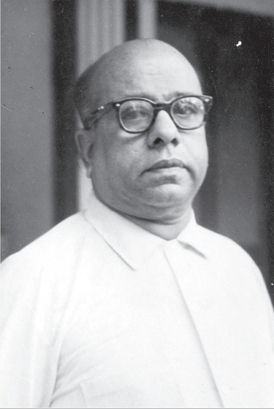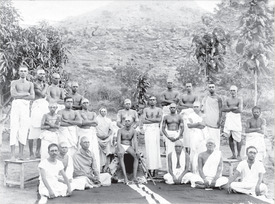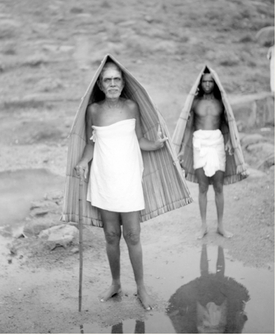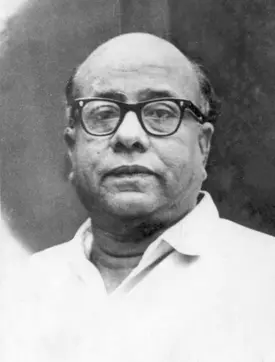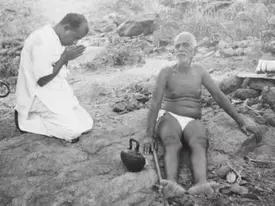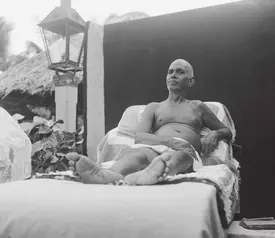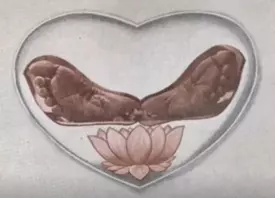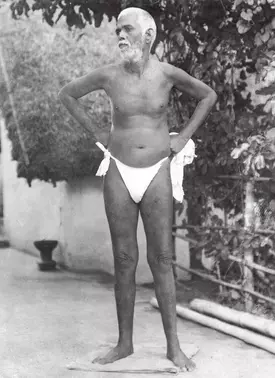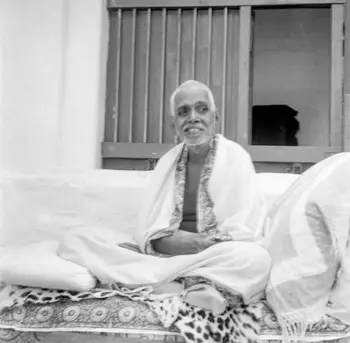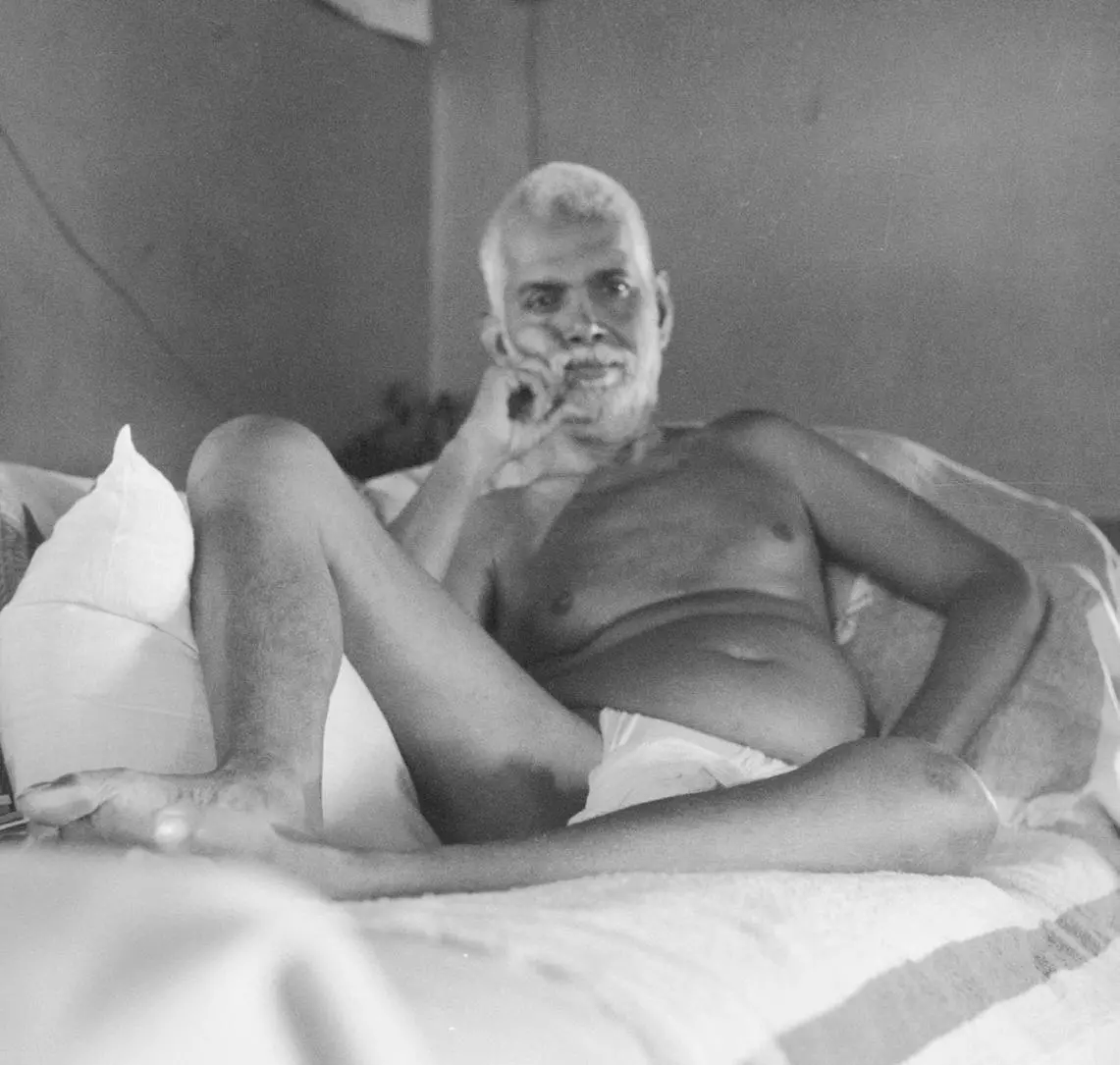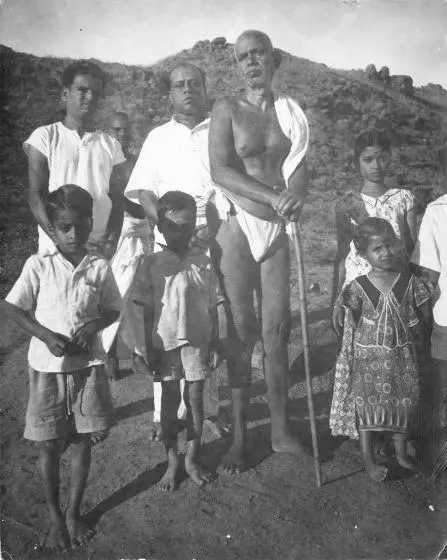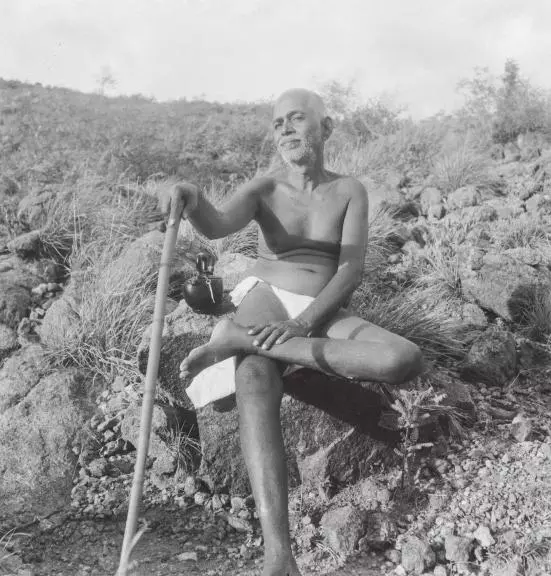Dr.T.N.Krishnaswami
In Profile [1]
Dr.T.N.Krishnaswami or TNK, as he was affectionately known, first saw Bhagavan in 1932 and was one of the witnesses of the signing of Bhagavan’s will in 1936. During his early visits to the Ashram, he obtained the role of Ashram photographer. He visited regularly for nearly twenty years and was always on hand to take a photograph. Indeed, of the 1,935 images featuring Bhagavan, 900 of the 1000 highest quality images, for which we have negatives, were taken by Dr TNK. It is hard to overestimate the value of this photographic collection, but Bhagavan seemed to know the importance they would have in the future. Bhagavan is said to have remarked, ‘What makes you think these are just photographs?’ On another occasion, he said, ‘Finally, these photos are all that will remain’.
In the following pages, we glimpse the life of a devotee who was key in bringing Bhagavan’s form to the world and in preserving his photographic image for future generations.] Dr T.N.Krishnaswami was studying medicine and was nearing his final examinations when he and a few student friends set out on an excursion to Vellore. Vellore district had been his native home as he was born into a Brahmin family of Gudiyatam.[2] TNK’s father, Nageswaran had been a successful ayurvedic physician in Gudiyatam but passed away when TNK was quite young. Thus the boy and his siblings were shifted to Madras to be under the care of their uncle, Seethapathy and it was Madras that he now called home and where he took up the study of medicine. [3]
On this trip to Vellore, the student carried his camera along and took pictures of the 16th-century Vijayanagara Fort at the centre of Vellore. His camera trained on stone carvings and archaeological places of interest. Someone suggested that they go see the temple at Tiruvannamalai and so they got a bus to make the 80 km trip southward and visited Arunachala temple. While photographing the impressive gopurams and other structures, a stranger suggested that they visit the Maharshi a couple of kilometres away. They covered the distance by horse cart and went in search of the Maharshi. None of his party had ever seen Bhagavan Sri Ramana before and, for TNK’s part, he had no conscious spiritual interest but was keen to have a good subject for photographic portraits. It was evening when they arrived. Devotees had left the hall and Bhagavan had gone for his usual walk on the hill:
We waited for a few minutes and saw a string of people following a tall man walking with a stick and holding a kamandalu. We alerted ourselves and I asked if I could take a few photographs of the Maharshi. The reply was ‘No, no, you cannot’. As we were talking, the tall stately figure approached us and asked what was the matter. Mr.Seshu Iyer, the man I had asked for permission, pointed to me and my colleagues and said, ‘This party are from Madras and they want to take some pictures of Bhagavan’. ‘Oh! Is that so?’ said the Maharshi. ‘Let them.’ So saying he stood posing for me with his hands on his hips and with his face in semi-profile. I lost no time. I opened my camera, brought it into focus and clicked three or four times, giving different apertures and different timings. I was not looking for any spiritual fare and I was not conscious of any holy atmosphere. [4]
Bhagavan entered the hall and lowered himself onto the sofa and pulled out a towel to wipe his feet. The young guests gingerly entered the hall:
It was surprising how he merged into himself totally oblivious of the surroundings. We entered the hall and sat a few feet in front of him. The Maharshi did not seem to take notice of anything around him. He wore a calm and distant look. His eyes shone and there was something divine about his countenance. The hall was badly lighted for photography but still I took a few pictures of the Maharshi. We then got up and mechanically prostrated before him and left the hall. Before we were out of the Ashram compound, a Sanyasi clad in orange robes came running after us and said, ‘Please send a few prints to the Ashram address. We do not have any good pictures of Bhagavan.’ This person was none other than Sri Niranjanananda Swami, the then Sarvadhikari.
I left the Ashram without giving any further thought to the matter and never suspected that the visit would play a vital part in my life. I returned to Madras, developed the film and sent a few prints to the Ashram. [5]
TNK turned to his studies, having mostly forgotten his visit to Ramanasramam until:
One morning I received a letter inviting me to come and take a group photo with the Maharshi, as all the devotees were impressed with the good picture that I had made. I wondered if this could not be put off till my examinations were over. But somehow, I found myself entrained for Tiruvannamalai. When I entered the Maharshi’s presence, he greeted me with a smile and said: ‘They want a group photo, and they want you to take it for them.’ I felt highly flattered, and I felt that I had done right in answering their call. To have been the object of Maharshi’s remark, was exquisitely pleasing. I arranged the group, erected my camera, and took a few pictures. Then Bhagavan posed for me in the conventional padmasana. Bhagavan sat almost statue-like, with a clean-shaven head.[6]
TNK’s gradual induction into the Ashram community seemed effortless:
On another visit, as I entered the hall, the Maharshi remarked ‘Just now we were talking about you and see the coincidence, you are here in person. You may yourself receive the letter personally which they have addressed ready for posting to you.’[7]
TNK never stayed overnight but during his day trips to tiruvannamalai, he made it a point to take as many pictures of Bhagavan as he could:
I used to wonder if such doggedness on my part would not vex the Maharshi. I snapped him walking, sitting, eating, cleaning his feet. I snapped him smiling, bursting into laughter, smiling at a child, in a meditative mood, in samadhi, etc. Once he was going up the hill when there was a slight drizzle, and he was offered a country-made palmyra umbrella. I took a picture of him while he was using this. I also took another picture of him using an ordinary umbrella. As i began to take this picture, the Maharshi smiled broadly. In the few hours that i spent with him, i felt charged with an inexplicable peace and contentment and returned home elated.[8]
Meanwhile TNK finished his studies and began to practice as a general physician with a specialisation in ophthalmology. He built up a thriving medical practice and enjoyed notable clientele. He married Janaki Ammal, built the family home in Mylapore which got the name ‘Malati’ and the couple had two sons, T.K.Natarajan and Ramana Kumar. All the while, he continued regular visits to the ashram.
One day, he and the Maharshi stopped up on the hill just beneath a large banyan tree and Bhagavan sat on a rock. TNK pointed out the similarity to the traditional depiction of Dakshinamurthi. Bhagavan playfully wanted to know whether Dakshinamurthi kept the left foot on the right knee or the right foot on the left knee. No one in the party seemed to know and Dr.TNK was not sure either. So, Bhagavan suggested they shoot the image in both postures. Thus, a series of photos was made just a little way up the hill with Bhagavan in Dakshinamurthi pose and in the alternate position.[9]
Even if such moments had up till this point been casual for TNK, over time he began to sense that these auspicious encounters with Bhagavan were not just about photography. Having lost his father at an early age, TNK would have been naturally drawn to someone who fit the bill so perfectly:
The Maharshi [began to seem like] someone I knew intimately. I felt at home in his presence and even expected some paternal indulgence and affection from him. I have no doubt that he did indulge me like a loving father. It is amazing how the thousands of visitors felt at ease in his presence and were made to feel that personal attention was bestowed upon each of them. My short walks with the Maharshi gave me the rare opportunity to listen and take part in the conversations.[10]
Even if it seemed to have been his dexterity with the camera that gave him such privileged access, TNK was beginning to be reshaped and mentored by something great, and at close range:
One day, as we were going up the hill, Bhagavan picked up a small glistening pebble from the path and held it out to me saying, ‘Someone from abroad has written asking for a stone taken from a holy part of this hill. He does not know that the whole hill is holy. The hill is Siva himself; as we identify ourselves with the body, so Siva has chosen to identify himself with this hill. Arunachala is pure wisdom appearing in the shape of a hill. It is out of compassion to those who seek Siva, that Siva has chosen to reveal himself as a hill visible to the eye. The seeker will obtain guidance and solace by staying near this hill.’
These words sank into my heart. It never occurred to me to weigh or examine the aptness of what was said. The hill was holy. The Maharshi had said it and that was what counted with me.[11]
Between visits to the ashram, TNK worked diligently to treat an endless stream of patients. He converted the front room of his house into a dark room, complete with processing equipment and chemicals for developing negatives. Over time he learned to make his own prints, and visitors in that time would have found prints hanging out to dry and the perennial scent of hypo, the photographic fixer used in the final steps of photographic processing.[12]
But visitors to Malati were not just patients. Many came for conversation knowing that it could be lively as TNK was slowly being powered up by his association with Bhagavan. Even if he had not intentionally embarked on a spiritual journey, the proximity with Bhagavan invariably drew him onto the path. When a visitor’s inquiries turned to faith matters, the goodly doctor shared some of the riches obtained during his visits to Ramanasramam. That the doctor had been won over to the spiritual life became increasingly evident to those around him and he was not averse to share it with others. On the question of the difference between the paths of devotion and wisdom, he has this to say:
Here is what the Maharshi says on the subject: ‘To long for happiness is bhakti. To long for the self is jnana.’ It is jnana to know that the master is within you, but to commune with him is bhakti. When the love of god or self is manifest, it is bhakti; when it is in secret it is jnana. Jnana and bhakti are like two sweets made out of the same sugar. You can choose whichever you like. Giving up ‘mine’ is bhakti; giving up ‘I’ is jnana. The former gives up all his possessions; the latter gives up the very possessor himself.[13]







Part 2
In the early years, TNK’s approach to Bhagavan had been quite different from that of other devotees as he was mainly concerned with taking photographs of Bhagavan. During his visits, his attention was rivetted on Bhagavan’s form rather than his words or teachings. If Bhagavan had not been concerned about his body, TNK studied the master’s physical form with great interest and looked for every detail and nuance in Bhagavan’s behaviour, endeavouring to capture it all on film.
Until then, TNK had not been focused on God or spirituality, and yet, he was not an atheist either rather only neutral with respect to religious life[14].
Something kept drawing him back. Overtly, the short trips from Madras were made purely out of photographic interest but, over time, mornings up on the Hill or at other sites around the Ashram became dear to him:
In the few hours I spent with the Maharshi, I felt charged with an inexplicable peace and contentment and I always returned home elated. My short walks with him gave me the rare opportunity of listening and taking part in the conversations. His person was seen and felt by me and I felt drawn and attracted to him. It gave me immense pleasure to take his pictures. He was more important to me than his teaching — every little movement, every one of his acts and gestures, was highly valued by me and they always carried some divine fragrance. Simply to watch him, no matter what he was doing, was gratifying. I was drawn to him like a baby to its mother.[15]
Dr TNK was always behind the camera and therefore rarely appeared in any of his frames. But one time he asked Bhagavan’s attendant to snap the photo.
For his photos, he kept the ‘medium format 2.25x2.25-inch negatives’[16] shot with his Rollieflex double-reflex camera.[17]
When early on he came at the request of the Ashram management to take a group photo, he also staged a photo of Bhagavan alone:
I arranged the group, erected my camera and took a few pictures. Then Bhagavan posed for me in the conventional padmasana, sitting almost statue-like, with a clean-shaven head.[18]
TNK sometimes enlarged his photos and printed them on canvas in order to paint over them in oils or in water colour.[19]
One example of this is the iconic painting that sits on Bhagavan’s sofa in the Old Hall. Though TNK was an avid painter and water-colourist, it was another painter, Raju&Sons, who produced this famous painting.
Bhagavan's Lotus Feet
Before taking a photo of Bhagavan, TNK always asked Bhagavan’s permission. Or at least, almost always. There was one series of photos for which he confessed to have quietly and stealthily photographed without first raising the issue with Bhagavan. These are images taken outside of the Old Hall next to the well where Bhagavan is reclining on his sofa. Some appear to be out of focus until one realises that the photographer had not trained his lens on Bhagavan’s face but on his feet. TNK had requested Bhagavan’s attendant to put a few flowers at His feet and as if prostrating before Bhagavan, he arranged the camera so that he could take the photo. Nonetheless, TNK’s efforts at concealing his true intentions were not lost on Bhagavan who seemed to have intuited what he had in mind from the beginning. However, he made no objection.
The best of the shots became important for TNK. He printed it, cut out the image of Bhagavan’s feet and painted a lotus blossom underneath them, a print which adorned Dr TNK’s office during the entirety of his medical career. Beyond that, the image served as the Ashram logo for many years and was included on the title pages of early Ashram publications.[20]Visits to the Ashram
Unlike other devotees, TNK never went for giri pradakshina, nor did he go for darshan to Arunachaleswar Temple in town. He neither took much interest in chanting, recitation, or study of the teaching, but instead occupied himself with Bhagavan alone:
Sometimes I used to wonder if it was not ridiculous of me to pay so much attention to photography when Bhagavan’s [principal] teaching was ‘I am not the body.’ Was I not chasing the shadow and even trying to perpetuate it? Somehow so long as I was [in the presence of] the Maharshi, his teaching did not assume any importance to me.[21]
Although it was photographing Bhagavan that had drawn him to the Master, he slowly became part of life in the Ashram and witnessed the many visitors, some of whom came in great distress.
Once a lady devotee who had strong faith in Bhagavan brought the corpse of her only child right into the darshan hall. Crying and lamenting, she said, “My son is dead. I pray and beseech you to grant him life.”
The Maharshi sat silent for a while, as was his custom, and then gently said, ‘Please remove [your son] to a nearby cottage and let us see what happens in the morning.i’ Nothing happened, and the following morning the boy remained inert. But in the meantime, something had transpired in the hearts of the relatives, and the mother finally acceded to family wishes that the corpse be cremated. The Maharshi subsequently commented: ‘Even an incarnate God cannot raise all the dead. He has no individual will so he cannot decide to perform a miracle. If miracles happened in his ambience, he witnessed them; that was all.[22]
Another Visit
On one visit in the 1930’s Dr TNK asked a friend to accompany him to Tiruvannamalai. The invitation was accepted spontaneously, so much so that the friend did not even go home to put on his shirt but set off immediately with Dr TNK in his dhoti and upper cloth with no more than three rupees in his purse. They travelled up to Katpadi by train and took a bus to Vellore where they got a bus for Tiruvannamalai. In Vellore, the friend wanted to take something to Bhagavan. On the roadside they saw a woman selling kovai kai. He bought the lot for a few annas. Since he had no luggage with him, he tied the vegetables up in one end of his upper cloth.
The two reached Tiruvannamalai that evening and the vegetable bundle was placed before Bhagavan as they paid their respects. When the bundle was opened, Sri Bhagavan saw the vegetables and said that if the kovai kai was cooked with brinjals, they would be very tasty. The next morning a devotee arriving from Madras via Villupuram brought brinjals, as if commanded by Bhagavan himself. The curry was cooked that morning and everyone relished the dish.[23]
The Boy and the Stick
TNK often brought one or both of his sons with him. In the New Hall TNK’s youngest son would recite rhymes before Bhagavan. Once, the boy noticed a devotee who brought a basket full of mangoes to Bhagavan. Bhagavan immediately began to distribute them to the monkeys. The devotee felt bad because Bhagavan did not even take one of the mangoes for himself. Bhagavan told him that once a gift is made, the receiver should be free to do with it as he wishes. Bhagavan assured the donor that his gift had been well-received and that he need not feel sorry.
Another time, this same boy awaited his father. It was a time following one of Bhagavan’s surgeries and Dr TNK was dressing the wound inside the dispensary. Meanwhile the boy was playing outside near the dining hall. When Bhagavan and Dr TNK emerged from the dispensary, Bhagavan jokingly said, ‘Kutti [little] Doctor is waiting.’ At that time, the boy paid no attention, but later, when he completed his studies in medicine and became a doctor himself, the words of Bhagavan hailing him as a doctor in the making seemed to have been a blessing for him to one day fulfil his call to the medical profession.
Feast at Skandasramam
TNK carefully observed Bhagavan in various situations within and around the Ashram and took photographs to record these events. He knew Bhagavan was fond of children and took a photograph of his son carrying Bhagavan’s walking stick.
In November 1945, Bhagavan and devotees spent a memorable day at Skandasramam. Nagamma eloquently describes the scene:
Sadhakas and sannyasins, lawyers and doctors, engineers and artists, newspaper correspondents and poets, songsters and a good many others arrived from Madras, Pondicherry and Villupuram. The young and old, the men and women and all without distinction of high and low, squatted on the ground around Bhagavan looking at him with a fixed gaze. While Arunagiri abounding in mineral wealth served as the precious jewelled throne, the clouds adorning the sky served the purpose of Sveta Chatram (the white umbrella) and the tree grove with innumerable branches acted as vensamarams (fans used in deity worship). Sri Bhagavan shone in his glory as an emperor crowned, while Prakritikanta (Nature personified) waved lights to him with its agreeable rays of the sun.[24]
TNK took about 35 photos at Skandasramam that day.
Photographic Non-duality
Following his surgeries, Bhagavan had the habit of entertaining his medical attendants with jokes alternating with profound spiritual commentary. Dr TNK’s friend, Dr Shankar Rao, had been attending on Bhagavan from the start of his illness.
On various occasions, he and Dr TNK marvelled at Bhagavan’s capacity to endure physical pain, not least of all, having undergone major surgery without general anaesthesia. One evening, the two doctors went to attend on Bhagavan and while Dr Rao was dressing the wound, Bhagavan commented on TNK’s photographs and gave a profound spiritual discourse using photographic processing and development as a teaching metaphor:
When taking a picture, the silver salts are coated over a film in the dark. And when the film is exposed in the camera, you get an impression caused by light outside. But if the film is exposed to light before you put it in the camera, there can be no impression on it. So is it with our jiva. When it is still in darkness, an impression can be made on it by the little light that streaks in. But when the light of knowledge has already flooded it, there is no impression of external objects to be obtained.[25]







Part 3
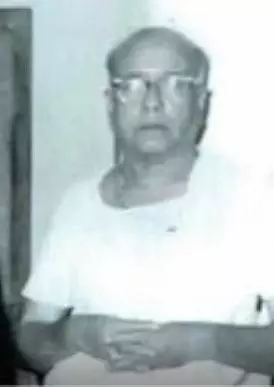
Visitors to Malathi
Malathi, Dr TNK’s family home in Mylapore, Chennai, became the ‘gateway’ to Ramanasramam. People would stay at Malathi on their way to the Ashram to meet Bhagavan. It was also a layover for devotees in transit on their way back home from Ramanasramam.
Muruganar used to come by car with TNK and spend time at Malathi during his trips to Madras for the purpose of proof reading and printing. He would sometimes stay to write for as long as a month. (Later TNK built a house in Tiruvannamalai which was exclusively made available for Muruganar’s stay.) When Muruganar was under medical treatment by TNK he also stayed for an extended period of time. Later some of Muruganar’s manuscripts were found in Malathi.
Malathi’s walls were filled with portraits of Bhagavan, either painted or coloured by TNK, and the family home had become ‘Ramanasramam Madras’, an outpost for the benefit of devotees. Yogi Ramayya would spend half his time in Tiruvannamalai and the rest at Malathi. He took delight in long discussions with TNK in Telugu on spiritual matters and Bhagavan’s teachings.
Ekanath Rao, T.S.Rajagopal Raoi, Sub-Register Narayana Iyer, T.P.Ramachandra Iyer, G.V.Subbaramaya, Ramanatha Brahmachari, G.V.Narasimha Rao, Ramanapadananda, Balarama Reddy, Dr.Mees, JJ Reed (Hamsa), the Bhatts and the Osbornes regularly stayed at the house, each enjoying Dr TNK’s warm hospitality. Framji Dorab who was based in Chennai often came for long hours to discuss Bhagavan. Visitors also sometimes assisted in transporting medicines from Madras to the Ashram. In later years, K.K.Nambiar and T.N.Venkataraman would come and discuss upcoming court cases.[26]
Kitty Osborne
In her girlhood, Kitty was among those who regularly came to stay at Malathi. It is said that that is where she learned the technique of ‘keeping the rice and rasam on the leaf ’. She speaks of those days with great fondness, telling how ‘TNK had one of the few cars in use in our orbit. He would pick me up from the school train coming up from Kodai to spend a day or two with him and his family and then we would drive to Tiruvannamalai’.
Kitty describes her experience:
TNK was down to earth, realistic, deeply devoted and had a great sense of humour and an infectious giggle. Sometimes I would catch his eye when someone was being overly pretentious, and he would swallow his laughter and try to look serious. I was less restrained!
On one of these visits, young Kitty, TNK and his family were at lunch. Kitty normally ate with the family in the kitchen passageway sitting on the floor while guests ate in the dining area. On this visit there were two guests, an Englishman and a Dutchman, sitting in the dining area having their meal. But one of the two seems to have objected to the other sitting and eating with him since he considered himself a Brahmin and did not extend this designation to his dining partner. A heated discussion ensued, and Dr TNK came to the rescue, moderating the debate until all was peaceful again. All this he did with utmost respect and kindness. When he returned to his meal in the kitchen passageway, Kitty and Dr TNK’s family were making every effort to restrain their amusement over what they had just heard taking place in the next room. But with their straight faces now blushing, an inflection point was fast approaching and when they could contain it no longer, all of them, including Dr TNK, burst into unbounded laughter.[27]
Visits to Ramanasramam
Dr TNK would sometimes transport guests from Malathi to Ramanasramam or from the Ashram to Malathi on his trips to and from Tiruvannamalai. One of his sons would join him on these visits. He would assist his father by holding rolls of film in the pockets of his shorts, or ‘half-pants’ as they were then called, the exposed rolls in one pocket and the new unexposed rolls in the other. Father and son would make a point of standing a little out of the way in the doorway of the darshan hall where they would handle the camera while taking pictures of Bhagavan, in order not to disturb devotees sitting in the Hall. His son invariably spent time with the other kids as well, especially when awaiting his father and Bhagavan returning from a walk on the Hill. He would listen very carefully and learned to recognise Bhagavan’s soft voice speaking Tamil in the Madurai style, making frequent use of ‘oye!’.[28]
After lunch, TNK would sit in the Ashram office and give medical consultations for inmates who would queue up outside to wait their turn.
Bhagavan’s Last Days
When Bhagavan fell ill in 1949, Dr TNK increased the frequency of his visits. As Bhagavan’s health declined, TNK would come from Madras three or four times each week, not returning to Malathi until about 2.30 am in the morning. Dr TNK writes:
He assured us that he was not going away. ‘People say that I am going away, but where can I go? I am here.’ Being universal, there was no going from here to there for him. Having realized that he was not this body, there was no return to any other body.[29]
As a health care professional, TNK found the casual manner with which Bhagavan encountered his physical condition nothing short of astonishing. In all his career, he had never seen or heard of a major surgery being performed without general anaesthesia. Even if local anaesthesia had been administered in some of the procedures (no doubt, to ease the mind of the surgeon more than anything else), Dr TNK’s medical training and decades of practice gave him a privileged perspective. He knew that a local anaesthetic could do next to nothing to counter the pain in the body from such an extensive surgical procedure, and yet, Bhagavan seemed to be more concerned about calming the fears and apprehensions of the surgeons and onlookers, even light-heartedly telling jokes. It was not that the Maharshi did not feel pain, TNK observed, but that he did not identify with it and could discuss it in a detached manner. The disease progressed:
I had the rare privilege of being allowed to stay with the Maharshi during the last days. Knowing full well that his end was near, I was inquisitive to watch and see if he would leave any message for us. Would he not speak words of solace? Would he not leave behind some directions for us? It was sad indeed to look at the suffering of the body. But the mystery was his attitude to it. He described all the pain and suffering as though the body belonged to someone else. The question arose whether he was suffering or not. How could he describe the pain and suffering so accurately and locate it in the body and yet remain unaffected by it? ‘There is a severe intolerable headache,’ he said as he was going into a slow uraemia and his kidneys were failing. The Maharshi never described the symptoms in a subjective manner.[30]
Bhagavan’s condition worsened. TNK describes the final day:
On the evening of the last day, the Maharshi asked to be propped up in a sitting posture. He tried to assume a semi-padmasana posture. His breathing was laboured and heavy. The attending doctor put the oxygen to his nose. Those around stood quietly by with bated breath. The Maharshi brushed aside the oxygen tube. There was a chorus of ‘Arunachala Siva’ from outside the room. The gathering stood dumbfounded. Would death dare to touch him? No, it is impossible. A miracle would happen.
But TNK’s medical savvy counselled him otherwise and he knew it would soon be over. He continues:
The atmosphere was tense with emotion, fear and expectation. There was some weeping. Very gently the Maharshi seemed to gasp a little and the body became still. Synchronized with the Maharshi’s last breath, a meteor was seen to trail across the sky. We could scarcely realise what had happened. He had left us once and for all. No more the beatific smile to greet us. No more the graceful form to adorn the Ashram. The Maharshi had deserted us! Were we to turn our backs on the Ashram and go home disappointed?[31]
After Mahanirvana
Like all Bhagavan’s devotees, Dr TNK struggled to make sense of it all. It barely seemed believable. He took refuge in Bhagavan’s teachings which, till then, he had largely ignored:
This gave me a severe jolt. I was shocked. Had I missed the opportunity of a lifetime to imbibe the teaching of the Enlightened One? I had done nothing in the direction of spiritual sadhana. Had I wasted all my time taking photographs while I should have engaged myself in trying to understand and practice his teachings in his presence? ‘No,’ I said to myself, ‘this cannot be true’. I was sure that I had obtained some grace from the Maharshi. He was somehow still here; only we must learn to feel his presence. We would never be forsaken for he had himself assured us that he was not going away. Then I turned to studying his teachings. I began to see light in them. Some of the sentences touched me and made me feel that I was in his presence, listening to him. I took heart. The more I read, the more intimate the Maharshi became to me. His teaching pulsated with life; I began to understand it and it mixed with my being and became my own.[32]
Writing on Bhagavan
Dr TNK couldn’t help but communicate some of what he experienced by this intensive excursion into the teaching and wrote a series of articles extolling Bhagavan and his teaching for The Mountain Path:
Those who saw the Maharshi sitting in samadhi were moved and awed by it. He radiated peace as the sun radiates light. His imperturbable composure impressed some, his lively explanations others, his grace and compassion yet others; some enjoyed his conversation and some his tremendous silence. Thousands flocked for a sight of him. People felt that here was God Incarnate walking on earth.[33]
After Mahanirvana, TNK found himself discussing Bhagavan’s teachings at every available opportunity. Following his consultation hours at Malathi, people would come, not with any physical complaint but to only hear Dr TNK’s reflections on spiritual issues. Bereft of Bhagavan’s physical presence, TNK continued with great intention the study of Bhagavan’s teaching. Indeed, many who had known him as a bhakta were surprised by the sudden intensity with which he attempted to grasp the teaching. He was still grappling with the loss of Bhagavan in the physical form but knew all the while that Bhagavan would give him the answer he was looking for:
A Guru is only for those who seek contact with him for the sake of spiritual understanding because this means seeking contact with the Truth in one’s own heart through him. One who lives at a distance and approaches him in this way may receive guidance, while one who lives near him may not know how to ask. ‘The real Guru is in the heart,’ the Maharshi said, ‘the task of the outer Guru is only to turn you inward to the Guru in your heart.’[34]
This had been the missing link in Dr TNK’s journey with Bhagavan up till that point. Bhagavan’s grace was now available in full measure:
We are told that the Divine dwells in the innermost recess of the heart, but how many of us are competent to look inward and realize it? The power of the Guru in helping one to do so is far more important than any merely verbal explanation he may give, for this latter touches only the mental understanding. ‘A silent Guru is very potent;’ said the Maharshi, ‘his work goes on inwardly where it is not apparent to the disciple.’ And he gave assurance that ‘as the disciple dives inwards in search of the Self, the Guru will do his part.’[35]
Dr TNK now understood that in the absence of Bhagavan’s physical form, he now must seek him within. This changed everything, even his understanding of treating his patients, healing the sick and the role that the Guru’s grace might play in such work:
If a sick man makes himself a recipient of this grace by his faith, he gets cured, but the cure is natural and spontaneous and not the result of any purpose or intention on the part of the Master. But what of healing by one who has not attained this supreme level? Can he influence God as an advocate influences a judge? What is it that heals and how is one to influence it? Bhagavan did not encourage pondering over such problems. They are of no help for spiritual progress. One should concern oneself with the Self alone. Whether the body is sick or well the ‘I’ [remains] the same. Bhagavan said that the primary disease, the root of all other diseases, is ignorance of the Self. The root symptoms of disease are body-consciousness and worldly consciousness. One should try to heal this main disease rather than the lesser diseases from which the body suffers.[36]
Now the disparate dimensions of TNK’s life began to dovetail and they became a seamless whole. He continues:
One should not be encouraged to seek the small solaces of this world as if they were the things of God. All experiences — birth and death, health and sickness, good and evil — are equally manifestations of one mind and are on the same level of reality or unreality as the mind.[37]
Following Bhagavan’s Mahanirvana, TNK’s immersion in the teaching went on as a matter of course but meanwhile, he remained diligent in maintaining his daily duties which now included administrative matters on behalf of the Ashram. Dr TNK and K.K.Nambiar initiated the construction of Bhagavan’s Samadhi. Decades before, as a trustee of the Ashram, Dr TNK had signed the will as a witness which would later help solve many disputes. He recalled the day this way:
During the Ashram court case regarding the Will, Bhagavan was asked for his signature. But the Master said, ‘What do you want me to sign? One man is saying that I am ‘Bhagavan’, another says ‘Ramana Maharshi’. As which do I put my signature?’ After devotees’ entreaties, Bhagavan put a few dashes and the court authority attested it by adding a seal. This shows his practical approach to liberation of a jivanmukta, signifies that he was nameless and formless. There is no name, as what name did he have, aside from that which we gave him.[38]
After Chinnaswami’s passing in early February 1953, TNK assisted T.N.Venkataraman in negotiating numerous challenges to the Ashram, not least of all legal battles. TNK would come to the Ashram each month to attend meetings and TNV frequently came to Malathi to discuss legal matters and other difficulties. In administration, TNK formed a team with K.K.Nambiar and other devotees and put themselves at TNV’s disposal.
During this period, even on the most sacred feast days such as Jayanthi or Aradhana, Dr TNK would forgo participation and remain deep in discussion with TNV. Only when it came time for arati would the two of them come out of the Ashram office.
TNK had been a member of the provisional Ashram Committee that had been set up and continued up until January 1964 when it was replaced by a Board of Trustees on a scheme laid down by the Government. According to the scheme, two members were nominated by the Ashram President and two by the government, with the Ashram President himself as the fifth. Dr TNK was one of the two members nominated by the Ashram President, T.N.Venkataraman.
Dr TNK spent the remainder of his years in service to the Ashram, immersing himself in Bhagavan’s teaching.
In 1972, Janaki Ammal, his wife of four decades, passed away. Three years later in April 1975, his friend, Srinivasan came to Malathi as usual to chant Vishnusahasranamam. While he chanted, Dr TNK lay comfortably on his reclining cot. It had been his lifelong habit to sleep in this semi-reclined position with the head propped up. So it was this position he took with eyes closed while listening to his friend’s recitation each day. On this day, however, as Dr TNK reclined and listened, he peacefully passed away.
Dr TNK left a treasure trove of photographic negatives of Sri Bhagavan and his devotees for posterity. The 'Dr.T.N.Krishnaswami and Smt Janaki Ammal Charitable Trust' was founded by friends and family and is registered in Tamil Nadu.
Citations
Jul/Aug 2012 – The Sat-Guru
Jan/Feb 2008 – Swami Ramanananda Saraswati [1]
Jan/Feb 2006 – How I Reached Bhagavan [1]
Nov/Dec 2006 – The Seeker Will Obtain Guidance and Solace [1]
Nov/Dec 2004 – 108th Advent at Arunachala Celebrations [1] [2]
Nov/Dec 2003 – Arunachala Everywhere [1]
Mar/Apr 1997 – By an Eye Witness [1]
May/Jun 1992 – Films from Sri Ramanasramam, part 6 [1]
[1] reproduced from the July 2021, Vol.15 No.7 of the Saranāgatī eNewsletter
[2] Though his grandfather hailed from Toppur (between Salem and Dharmapuri), in the early 1800s a famine broke out in the region and the family was compelled to shift to Gudiyatam. Once settled there, TNK’s grandfather, Venkataraman Śāstṛi looked after a small temple there.
[3] Raghu Toppur, TNK’s eldest grandson, in a public talk 19th May, 2018 at the Bay Area Satsang on the occasion of Bhagavan’s 68th Aradhana function in Fremont, CA.
[4] ‘How I Came to the Maharshi’, The Mountain Path, July 1968
[5] Ibid.
[6] Ibid.
[7] Ibid.
[8] Ibid.
[9] Raghu Toppur in talk at the Bay Area Satsang, 19th May, 2018
[10] ‘How I Came to the Maharshi’, Mountain Path, July 1968 p.195-6
[11] Ibid.
[12] Raghu Toppur in talk at the Bay Area Satsang, 19th May, 2018
[13] ‘Jnana and Bhakti’, The Mountain Path, Oct 1964, p.222-223.
[14] TNK’s eldest son, T.K.Natarajan, in video interview, VC.91/DV.78
[15] ‘How I Came to the Maharshi’, The Mountain Path, July 1968
[16] See John Maynard’s, ‘The Archives of Sri Ramanasramam’ The Mountain Path, April 2010, p.92
[17] The family of Dr T.N.Krishnaswami presented the Ashram archives with his Rolleiflex camera to preserve for posterity
[18] How 33I Came to the Maharshi’, The Mountain Path, July 1968
[19] 'Introducing', The Mountain Path, January 1965, p.63
[20] Raghu Toppur, Dr TNK’s eldest grand son, in talk at the Bay Area Satsang, 19th May 2018
[21] How 33I Came to the Maharshi’, The Mountain Path, July 1968
[22] ‘T.N.Krishnaswami’, Face to Face, p.257
[23] ‘Incidents Connected with the Life of Sri Bhagavan’, M.V.Krishnan, Mountain Path, July 1979 p.223
[24] Letters from Sri Ramanasramam, 26?November?1945
[25] Call Divine, vol 9, Sept. 1960, p.19, Dr Shankar Rao, D.M.O.
[26] Video interview with Dr TNK’s eldest son, T.K.Natarajan
[27] From a private conversation with Kitty
[28] In an email from Raghu Thoppur, TNK’s eldest grandson
[29] ‘The Sat-Guru’ by TNK, 'The Mountain Path', Jul 1965 pp.152-54
[30] ‘By an Eye Witness’, by Dr TNK, 'The Maharshi', Mar / Apr 1997
[31] Ibid.
[32]cw 'How I Came to the Maharshi' Jul 1968, pp.194-196
[33] ‘The Sat-Guru’ by TNK, The Mountain Path, Jul 1965, pp.152-154
[34] Ibid.
[35] Ibid.
[36] ‘The Maharshi and Healing’ by Dr TNK, The Mountain Path, January 1966, pp.25-27
[37] Ibid.
[38]cw A video interview with Dr.TNK’s second son, Dr.T.K.Ramana Kumar, recorded in May 2002

